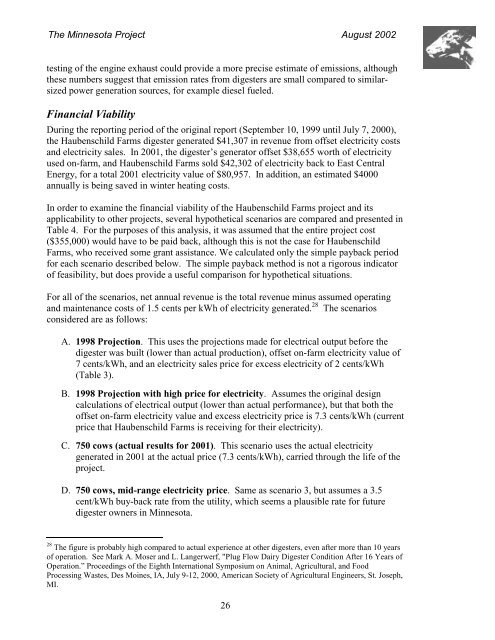Haubenschild Farms Final Report - The Minnesota Project
Haubenschild Farms Final Report - The Minnesota Project
Haubenschild Farms Final Report - The Minnesota Project
Create successful ePaper yourself
Turn your PDF publications into a flip-book with our unique Google optimized e-Paper software.
<strong>The</strong> <strong>Minnesota</strong> <strong>Project</strong> August 2002<br />
testing of the engine exhaust could provide a more precise estimate of emissions, although<br />
these numbers suggest that emission rates from digesters are small compared to similarsized<br />
power generation sources, for example diesel fueled.<br />
Financial Viability<br />
During the reporting period of the original report (September 10, 1999 until July 7, 2000),<br />
the <strong>Haubenschild</strong> <strong>Farms</strong> digester generated $41,307 in revenue from offset electricity costs<br />
and electricity sales. In 2001, the digester’s generator offset $38,655 worth of electricity<br />
used on-farm, and <strong>Haubenschild</strong> <strong>Farms</strong> sold $42,302 of electricity back to East Central<br />
Energy, for a total 2001 electricity value of $80,957. In addition, an estimated $4000<br />
annually is being saved in winter heating costs.<br />
In order to examine the financial viability of the <strong>Haubenschild</strong> <strong>Farms</strong> project and its<br />
applicability to other projects, several hypothetical scenarios are compared and presented in<br />
Table 4. For the purposes of this analysis, it was assumed that the entire project cost<br />
($355,000) would have to be paid back, although this is not the case for <strong>Haubenschild</strong><br />
<strong>Farms</strong>, who received some grant assistance. We calculated only the simple payback period<br />
for each scenario described below. <strong>The</strong> simple payback method is not a rigorous indicator<br />
of feasibility, but does provide a useful comparison for hypothetical situations.<br />
For all of the scenarios, net annual revenue is the total revenue minus assumed operating<br />
and maintenance costs of 1.5 cents per kWh of electricity generated. 28 <strong>The</strong> scenarios<br />
considered are as follows:<br />
A. 1998 <strong>Project</strong>ion. This uses the projections made for electrical output before the<br />
digester was built (lower than actual production), offset on-farm electricity value of<br />
7 cents/kWh, and an electricity sales price for excess electricity of 2 cents/kWh<br />
(Table 3).<br />
B. 1998 <strong>Project</strong>ion with high price for electricity. Assumes the original design<br />
calculations of electrical output (lower than actual performance), but that both the<br />
offset on-farm electricity value and excess electricity price is 7.3 cents/kWh (current<br />
price that <strong>Haubenschild</strong> <strong>Farms</strong> is receiving for their electricity).<br />
C. 750 cows (actual results for 2001). This scenario uses the actual electricity<br />
generated in 2001 at the actual price (7.3 cents/kWh), carried through the life of the<br />
project.<br />
D. 750 cows, mid-range electricity price. Same as scenario 3, but assumes a 3.5<br />
cent/kWh buy-back rate from the utility, which seems a plausible rate for future<br />
digester owners in <strong>Minnesota</strong>.<br />
28 <strong>The</strong> figure is probably high compared to actual experience at other digesters, even after more than 10 years<br />
of operation. See Mark A. Moser and L. Langerwerf, "Plug Flow Dairy Digester Condition After 16 Years of<br />
Operation.” Proceedings of the Eighth International Symposium on Animal, Agricultural, and Food<br />
Processing Wastes, Des Moines, IA, July 9-12, 2000, American Society of Agricultural Engineers, St. Joseph,<br />
MI.<br />
26
















